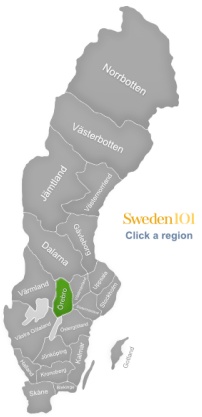Örebro - Örebro Castle, Olaus Petri Church, Kvarntorpshögen, Nora, Arboga

What does the name Örebro mean?
The name of the region (and city of the same name) Örebro can be translated quite literally as “bridge over gravel banks”, and if you have a look at the geography of the region, then it also becomes quite clear why this name was chosen for the region.
What is the region's historical importance?
The region of Örebro was a center of trade for the Scandinavian region during the Middle Ages, and hence used to be quite wealthy and important. Even though Örebro, the city, was important during that time, it always remained rather humble in its size until later on when the shoe production started. The city then grew rapidly, and today is one of the six largest cities in all of Sweden, and also one of the largest inland centers of the country.
What is the region known for?
Örebro once was known as a region that was producing plenty of shoes, but today it's more likely that you heard the name Örebro because it is home to one of Sweden's most beautiful castles, and also to the park that has been voted the most beautiful in Sweden. So basically, if you're into beautiful parks and castles, then Örebro is the place for you. Of course, shoes can also still be found in this region if you would like to combine all the culture with some shopping.
What are some places you need to visit in Örebro?
Örebro is a nice place to visit as you can combine all sorts of interests with another, like shopping and culture, or culture and hiking. You can do one thing in the morning, and the other in the afternoon – there are plenty of opportunities for everybody. Here are some of the highlights:
Örebro Castle
Örebro Castle is one of the most popular castles in Sweden, which might have to do with the scenic setting next to the water which reflects the image of the castle beautifully when the weather is right. The oldest part of the castle dates back to the second half of the 13th century, but most other parts of the fortification that sits on an island in the river are a bit younger than that. Most of the castle was finished by the 16th century, and during the 19th century parts of the castle were rebuilt. It is a wonderful place to visit and take photos of. Some rooms within the castles are used as classrooms today – imagine how great that must be for the students!
Olaus Petri Church
The Olaus Petri Church is one of the most popular churches in the city, so while you are there, you should drop by and take a few photos!
Kvarntorpshögen
If you would like to have some nice views from a 157m high mountain, then Kvarntorpshögen might be a good place for you. There is also something special about this mountain: it's not a natural mountain but made by men! The top of the mountain can be reached by car or by walking (which is the nicer experience because then you feel like you've earned the view as a reward – and 157m really isn't that much of an effort). The view is not the only reward that waits for you at the top of the mountain: it is also a place where a variety of artists have left their mark.
Nora
If you would like to see one of the best preserved wooden cities in Sweden, then you need to head to Nora, as there are not many other places where you can see such a big number of original wooden buildings from the 18th and 19th century. Nora also has an interesting railway museum.
Arboga
Arboga is a must if you would like to know more about the region's importance during medieval times as Arboga used to be one of the most significant places during those times. In 1435, Sweden's first parliament was held in Arboga, and it was also a religious center because of the Franciscan monks that settled in the region during the 13th century. The monks usually settled down in areas in which they saw potential for growth, and they saw that in Arboga. They were quite valuable for the inhabitants, too, because their mission always was to help. They looked after the sick and poor, and in general did a lot of good for Arboga. Unfortunately, the monks were driven out of the country during the 16th century when the king had some serious issues with the Catholic church. Go to Arboga to learn more about this fascinating part of Swedish history.

_(2).jpg)